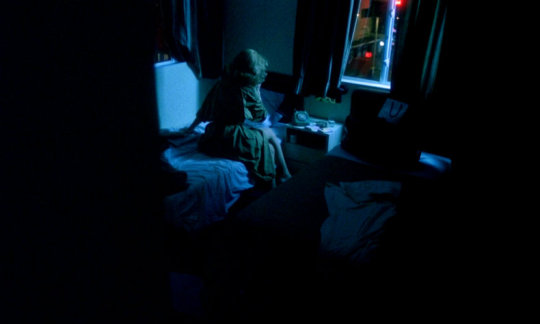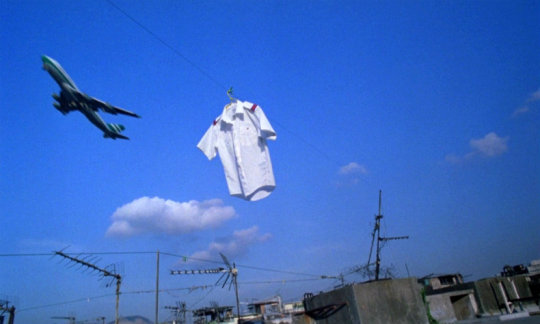Text
We never left
A place / we were always leaving
A time. A violence.
A body.
Each other.
0 notes
Quote
The bad reading [of Gender Trouble] goes something like this: I can get up in the morning, look in my closet, and decide which gender I want to be today. I can take out a piece of clothing and change my gender: stylize it, and then that evening I can change it again and be something radically other, so that what you get is something like the commodification of gender, and the understanding of taking on a gender as a kind of consumerism … When my whole point was that the very formation of subjects, the very formation of persons, presupposes gender in a certain way—that gender is not to be chosen and that “performativity” is not radical choice and it’s not voluntarism … Performativity has to do with repetition, very often with the repetition of oppressive and painful gender norms to force them to resignify. This is not freedom, but a question of how to work the trap that one is inevitably in.
Judith Butler (via overcoding)
9K notes
·
View notes
Photo



I can’t see me loving nobody
But you for all my life
Happy Together (1997) (Dir. Wong Kar-Wai)
8K notes
·
View notes
Photo

Taho. Anytime. Anywhere. 😁 #vscocam #vsco #vscofilter #vscoph #vscofood #vscofollow #instafood #food #foodstagram #foodnation #taho #soy by Ina Navarro on Flickr.
42 notes
·
View notes
Text
If you won't build a city with me, I'll build it myself or find someone else who isn't afraid of that ambition. I refuse to suburbanize love. I will neither settle nor settle down. No white picket fence in our future. No garden troll, no pink flamingo.
1 note
·
View note
Quote
Let everything happen to you: beauty and terror.
Just keep going. No feeling is final.
Rainer Maria Rilke, from The Book of Hours (via liquidnight)
43K notes
·
View notes
Photo

Gun Dealers’ Daughter by Gina Apostol
In Gina Apostol’s novel Gun Dealers’ Daughter, rich bookworm Soledad Soliman recounts from her home in Manhattan of when she joined a group of radicals in 1980 Manila, Philippines, during the reign of the dictator President Marcos. She falls for her fellow rich neighbor Jed and his striking girlfriend, Soli. Suffering from the affects of her suicide attempts and her past trauma, her memory is fractured which makes for a strangely worded story but there is a certain elegance to it. It makes you question if she just imagined some or even all of it, but wow what a ride.
Read more of Eileen’s review here!
6 notes
·
View notes
Video
instagram
WWAWWD?
1 note
·
View note
Photo


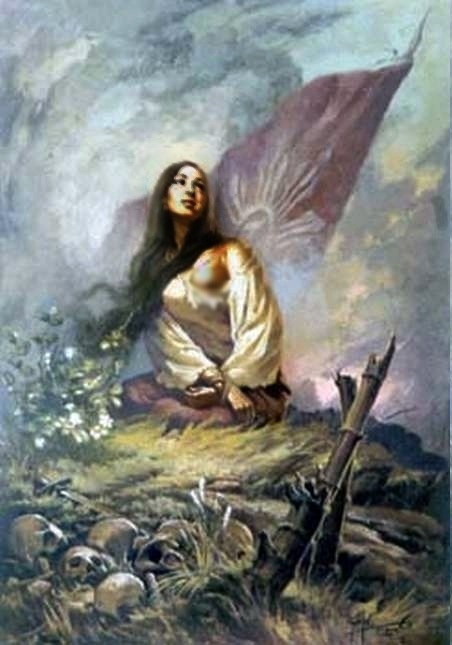


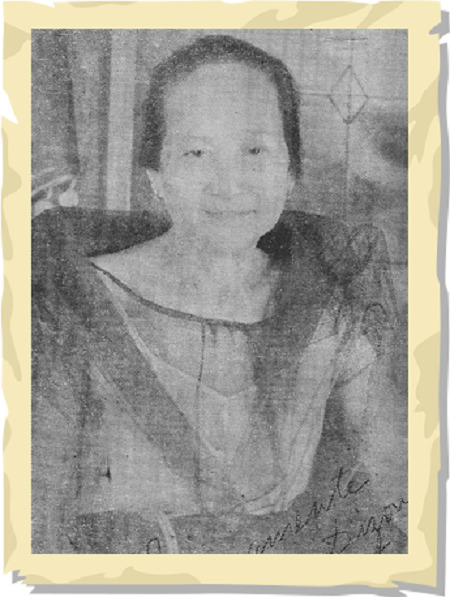
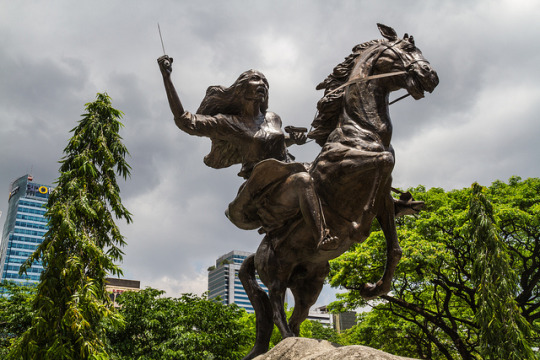


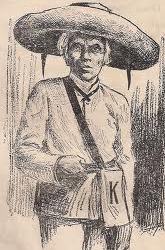
10 Kickass Pilipina Warriors in History That You Probably Never Heard Of
We have all heard of Jose Rizal, Datu Lapu-Lapu, Andres Bonifacio, Apolinario Mabini, etc . But these are all men, what about the role of women? Surely enough women played a major role throughout our history and were brave warriors fighting along side our men for our freedom from Spain, the Japanese occupation, and the U.S. These women were fierce, fighting in battles, some being generalas, leading revolts against their colonizers, and fighting side by side with men as equals. They fought, bled, and died for us, our people, nation, and freedom and deserve to be known for their fierceness.
So here are 10 Kickass Pilipina Warriors whose names and accomplishments you should learn and who cast aside the submissive, timid, Maria Clara stereotype that Spain encouraged our women to be.
1.) Melchora Aquino
Also known as Tandang Sora, “Elder Sora” due to her old age at 84 years old when the Philippine Revolution broke out, she was born on January 6, 1812 in Caloocan. She was known as the “Mother of the Katipunan” and fearlessly aided the soldiers giving them food and shelter despite the warnings of Spanish authorities of those aiding the rebels would receive severe punishment from imprisonment to death. Born in a peasant family to Juan and Valentina Aquino, she never attended school but she was still literate at an early age and was known for her singing and pageantry as the role of Reyna Elena in Santa Kruzan festivals. Her store in her native hometown became a refuge to wounded and sick revolutionaries whom she fed, gave medical attention, and encouraged with motherly advice. She also housed secret meetings of the Katipunan in her home. When Spanish authorities found out about her role in aiding the Katipuneros and her knowledge of their whereabouts, she was taken and interrogated but she refused to give in and give up any information. For this she was then arrested by the guardia civil and deported to Guam where she stayed in exile until the U.S. colonization when she, like many exiles, returned to the Philippines where she died on March 2, 1919 at the old age of 107. Her remains were transferred to her own backyard which is now known as Himlayang Pilipino Memorial Park in Quezon City.
2.) Gregoria de Jesus
Also known as Aling Oriang, she was the wife of Andres Bonifacio, one of the founding fathers of the revolutionary secret society Katipunan. She was born on May 9, 1875 in Kalookan. Gregoria was initiated as the Lakambini (muse) of the society where she was entrusted with the important role of custodian of documents. If not for her, Pilipin@s today would not have a broad knowledge about the organization of the Katipunan. When the Katipunan was discovered, she joined the men in the battlefields. Her nom de guerre was Manuela Gonzaga. Gregoria and Bonifacio had a traditional religious wedding at the Binondo Church, followed a week later by a ceremony according to the Katipunan’s rites, as the society’s members did not approve of their marriage in the Catholic Church, which was seen as an oppressive colonial force. On the evening of the same day, the women’s chapter of the Katipunan was formed, and she was appointed its vice-president and the custodian of the society’s documents, swearing fealty to the group’s purposes. When the Guardia Civil inspected homes unannounced, De Jesús would gather all the secret society’s documents and drive all night around town in a calesa, returning home only when assured of safety. She died in 1943 during the Japanese Occupation.
3.) Generala Agueda Kahabagan
Known as the “Joan of Arc of the Tagalogs”, she was the first and only female general in the army of the Katipunan. Not much is known about her and no photo of her exists but with the little information we do know of her from historical records she was known for her bravery in battle with both the Spanish and Americans. She was commissioned by General Miguel Malvar to lead troops of men armed with rifles and knives into battle. In October 1897, Agueda Kahabagan joined General Artemio Ricarte in a three-day attack on the San Pablo garrison in Laguna. While riding a horse, with a rifle in one hand and a bolo in the other, she led her men and fought against the enemy. Accounts of her mentions how she was reportedly often seen in the battlefield dressed in white, armed with a rifle and brandishing a bolo. In March 1899, she was listed as the only woman in the roster of generals of the Army of the Philippine Republic and was appointed on January 4, 1899.
4.) Teresa Magbanua
Born in Iloilo, Panay, she was known as the “Joan of Arc of the Bisayans”. She was a school teacher and military leader who was one of the few women who joined the Panay-based Bisayan revolution. As a child she was known to be very outgoing and tomboyish in which her parents were concerned over her behavior. She is remembered by one of her sisters as a “dynamic personality, restless, and unafraid of any man”. She eventually married Alejandro Balderas, a wealthy landowner, and quit being a school teacher to be a housewife. While working on her husbands lands she learned how to shoot a pistol and ride a horse. When the revolution started, despite strong opposition from her husband, she joined her two younger brothers, Pascual and Elias, in arms against the Spanish forces and joined the Katipunan. She was enlisted under her uncle, Major General Perfecto Pablador, and eventually took charge of the Administrative Division.
On December 3, 1898, she led her forces on horseback and fought and defeated Spanish troops at the Battle of Barrio Yoting, which took place in Pilar, Capiz. From her accomplishments during her first battle she earned her name as the “Bisayan Joan of Arc”. She was also fondly known among her troops as “Nanay Isa” or “Nay Isa”. On December 3, 1898 Magbanua led her troops against Spanish forces once again at the Battle of Sapong Hills near Sara. Magbanua. They won despite the odds being heavily in favor of the Spanish. Soon, Magbanua’s forces were joined by revolutionary forces from Antique, under the command of General Leandro Fullon, for a march on Iloilo City. On December 24, 1898, Magbanua participated in the liberation of Iloilo City, alongside Generals Martin Delgado, Roque Lopez, Quintin Salas and others. Along with the other generals, Magbanua helped circle Iloilo City, allowing General Delgado to enter and retake the city from the Spanish.
After the revolution she then shifted focus on fighting against the Americans during the Philippine-American War alongside her brothers. On February 11, 1899, Magbanua fought in the Battle of Iloilo City. Along with General Martin Delgado, Magbanua defended Iloilo City against the advancing forces of Brigadier General Marcus Miller.This battle ended in defeat for Magbanua and Delgado, as American forces took Iloilo without a single reported casualty. On March 10, 1899, Magbanua participated in the Battle of Balantang, Jaro, along with her brother Pascual. This battle resulted in Philippine forces retaking Jaro from the Americans where 400 Americans were killed in the fighting. For her valor, Magbanua was given a prominent place in the celebration, and led her troops into the city while riding a white horse. In 1988, she participated in the defense of the Balantang-Tacas-Jiabo-an line. The celebrations would not last long however as soon tragedy struck when her brother General Pascual Magbanua died in December 1899 at the age of 24 and her other brother, Major Elias at the age of 19 both dying under mysterious circumstances which took a big toll on her.
During the Japanese occupation in World War II, though she didn’t actively fight this time around she still resisted Japanese forces by selling all the things she owned to buy food and supplies which she provided for the guerrilla forces. After the death of her husband she then sold her property in Iloilo to help finance the guerrilla forces. She later moved to Zamboanga del Sur in Mindanao with her sister, Maria, where she eventually died sometime in August of 1947.
5.) Nieves Fernandez
Captain Nieves Fernandez who was formerly a school teacher, was the only known Pilipina guerrilla leader during the Japanese occupation of the Philippines. She worked with guerrillas south of Tacloban and rounded up people to resist the Japanese. As a guerrilla leader she commanded 110 Pilipin@s who killed more than 200 Japanese with knives and shotguns made from sections of gas pipe which are known as latong in central Bisayas and palitik in Tagalog. They loaded these makeshift guns with gunpowder and old nails. They also made grenades and occasionally took Japanese weapons. Because of her forces and her leadership, the Japanese offered 10.000 pesos to anyone for her head. Throughout her fighting career she was wounded only once, where she developed a scar on her right forearm from the bullet wound. When the Japanese came to take the children under her care she shot them with her latong. In her picture above (the 5th photo), she demonstrates to U.S. Army Pvt. Andrew Lupiba how she used her bolo to silently kill Japanese sentries during the occupation of Leyte Island.
6.) Marina Dizon
Born on July 18, 1875 in Tondo, Manila, she was one of the first women to join the Katipunan in July 1893. She was also a daughter of Jose Dizon, a Katipunan leader in Cavite and one of the Thirteen Martyrs of Bagumbayan who was executed by the Spanish officials in 1896. In 1893, Marina accompanied her cousin Emilio Jacinto to the house of Don Restituto Javier. It was there that she and a number of other women were initiated into the Katipunan. Marina became an active member, presiding over initiation rites, keeping records, and teaching new members the constitution and teachings. Marina always said, “Be cheerful at all times, do not show signs of any impending rebellion. Be prepared to be orphans and widows. Be brave and carry on”. These are the words that inspired the women of the Katipunan. When her father was executed in Bagumbayan in 1897 and her husband was arrested in August of the same year, she burned all the records of the Katipunan in order to prevent the Spaniards from learning more about the group. She then sold all her belongings to raise money to bribe her husband’s guards when finally, her husband was released on September 11, 1897.
7.) Gariela Silang
Gabriela Silang is probably one of the only women whose name is widely known among Pilipin@s. María Josefa Gabriela Cariño Silang was born on March 19, 1731 in Caniogan, Ilocos Sur to an Ilokano father and Tinguian mother from Abra. She was the first Pilipina to lead a revolt during the Spanish colonization of the Philippines and was an active member of the revolutionary force of Ilokano leader Diego Silang, her husband, in which she led the group for four months after his death before she was captured and executed.
She was adopted by a wealthy businessman who later married her at the age of 20, but left after three years. In 1757, she married again, this time to 27-year-old indigenous Ilokano rebel leader, Diego Silang. She became one of his closest advisors, a major figure in her husband’s collaboration with the British and the brief expulsion of Spanish officials in Vigan, Ilocos Sur.
On May 28, 1763, her husband was assassinated by order of royal and church authorities in Manila. After her husband’s death, she fled on horseback to the mountains of Abra, her mothers homeland, to establish her headquarters, reassemble her troops, and rally the Tingguian community to fight. They descended on Vigan on September 10, 1763. But the Spanish garrison was ready, amassing Spanish, Tagalog, and Kapampangan soldiers and Ilokano collaborators to ambush her and rout her forces. Many were killed and her men were hanged along the coastal towns as a warning to other Ilokanos that any resistance to Spain would lead to death. She escaped, alongside her uncle Nicolas and seven other men, but was later caught on September 29, 1763. They were summarily hanged in Vigan’s plaza, with Gabriela being the last to die.
Her ferocity and death became a symbol for Pilipinas, their pre-colonial importance in Filipino society and their struggle for liberation during colonization. Today there are several monuments in honor of this Ilokano and Tinguian heroine, one of them at the heart of Ayala Avenue in Makati City in 1971 created by Jose M. Mendoza and was placed by the Zobel de Ayala Family and inaugurated by Gabriela Silang’s great-granddaughter Gloria Cariño and her great-grandson Mario Cariño Merritt.
8.) Remedios Paraiso-Gomez (Kumander Liwayway)
Kumander Liwayway was one of the highest ranking female commanders of the anti-Japanese army Hukbong Bayan Laban sa Hapon (Hukbalahap). She was a fearless and intrepid lady commander of Kapampangan descent who led her squadron into many successful battles against the Japanese occupiers.
She was very feminine and never hid it. However her femininity didn’t deter her fierceness as a headstrong commander who often polished her nails and wore makeup such as her signature bright red lipstick before leading the Huk troops into battle. Her feminine ways often both amused and irritated her comrades but she proved that she didn’t have to act like a man to fight like one of them as women were just as equal and strong fighters to men.
Her bravery made Huk Supremo Luis Taruc declare that “the role of women was one of the proudest features of the Hukbalahap.” When President Manuel Roxas scolded her after her capture, she told him “You are wrong, Mr. President” right to his face.
In the 2009 book, Kumander Liwayway, written by her younger brother Andrew Gomez, which told her life story, one passages says, “At the top of the Camansi plateau, the guerrillas were ready and just waiting for the appearance of the Japanese soldiers. Ka Li (Paraiso) was observed by her group that she looked different at that time because she was fully made up with matching bright red lipstick and her hair was well-combed.”
“Her troops were surprised to see their commander so dressed up, as if she was going to a social function. But in the current situation, her men pictured her as a fearless and courageous leader unafraid to die. Her appearance inspired her men and motivated them to fight harder.”
“One of the things I am fighting for in the Huk movement is the right to be myself,” Paraiso was quoted as saying when her comrades confronted her about wearing lipstick and being feminine. She even challenged a comrade named Katapatan to a duel because she felt disrespected by his sexual innuendos.
In May 1942 at the age of 22, she along with her brother, Oscar, joined the Hukbalahap command of Eusebio Aquino to avenge the murder of their father, Basilio, a vice mayor of Mexico (the town in Pampanga not to be confused with the country), by the Japanese. Basilio worked with Pedro Abad Santos, one of the founders of the Socialist Party of the Philippines and older brother of former Chief Justice Jose Abad Santos.
She returned to the underground when Huk leaders and members, like her brother, were killed and arrested despite an amnesty. The Philippine Constabulary caught her twice, first in Arayat town, Pampanga, and second in Iloilo province. In both, she was cleared of murder charges. “Pilipin@ women played an important role during the war. Like their male counterparts, they held responsible positions in fighting the enemies,” Paraiso once said. “They dedicated their lives to a noble cause not only to drive away the Japanese invaders but [also] to pursue the struggle for genuine freedom, true justice and democracy … I hope that someday, the role of these unsung heroines will find a place in history.” She died recently earlier this year in May at the age of 94 in her home in Quezon City due to cardio-pulmonary arrest.
9.) Salud Algabre
She was a revolutionary who actively took part in the Sakdalista Uprising, a peasant rebellion in 1935 and was the only female in the movement. Her interest in the movement came from when she read a copy of the Sakdal which had been given to her by a relative. When asked what is the Sakdals were fighting for, she unhesitatingly answer, “to be independent.”
The Sakdal Uprising on May 1935 took place in the provinces of Bulacan, Cavite, and Laguna. According to historians the uprisings aim was to create disorder to prevent the holding of a plebiscite to approve the Constitution of the Philippine Commonwealth as the Sakdals did not accept the Commonwealth as it didn’t represent full independence.
Her famous quotes are:” No uprising fails. Each one is a step in the right direction.” ” In a long march to final victory, every steps counts, every individual matters, every organization forms part of the whole.”
10.) Trinidad Tecson
Known as the “Mother of Biak-na-Bato”, she was born in San Miguel de Mayumo, Bulacan November 18, 1848. She joined the Katipunan and is the only known woman to undergo the sacred rites called Sandugo, which was signing the Katipunan contract and pledging loyalty by signing in one’s own blood.
She fought in battles wearing a Katipunero outfit and survived fatal wounds numerous times. She also organized and led a group of women who would nurse sick and wounded Pilipin@ soldiers during the war. One of her valiant acts was seizing munitions from the civil guards at Caloocan as well as the capture of firearms from a jail in San Isidro. During one of these exploits, Tecson once pretended to be dead in order to evade capture.
She joined with the forces of General Mariano Llanera wearing the male uniform called “rayadillo” in her battles. Other battles she fought in were under Gen. Francisco Makabulos in the battles of Zaragosa and San Antonio in Nueva Ecija; under Gen Isidro Torres in the battle of San Rafael; and under Gen. Mariano Llanera in the battle of San Miguel, Baling Kupang, Biak- na-bato, San Ildefonso and Cabanatuan. She was also in the battles of Dagupan, Malabon, Manila and San Isidro. For her efforts, Tecson received a post-war recognition from the American Red Cross when she later became known as The Mother of the Philippine Red Cross. Trinidad Tecson died in 1928 at the age of 80.
2K notes
·
View notes
Quote
The obsessive masculine subject is constantly locking the doors of the symbolic order through which he might slip [away from it], while the feminine is constantly knocking on the doors.. This is why the masculine cannot respond to the feminine - she is the reminder of the open door.
Turning Law Inside-Out - JEANNE SCHROEDER (via alterities)
31 notes
·
View notes

